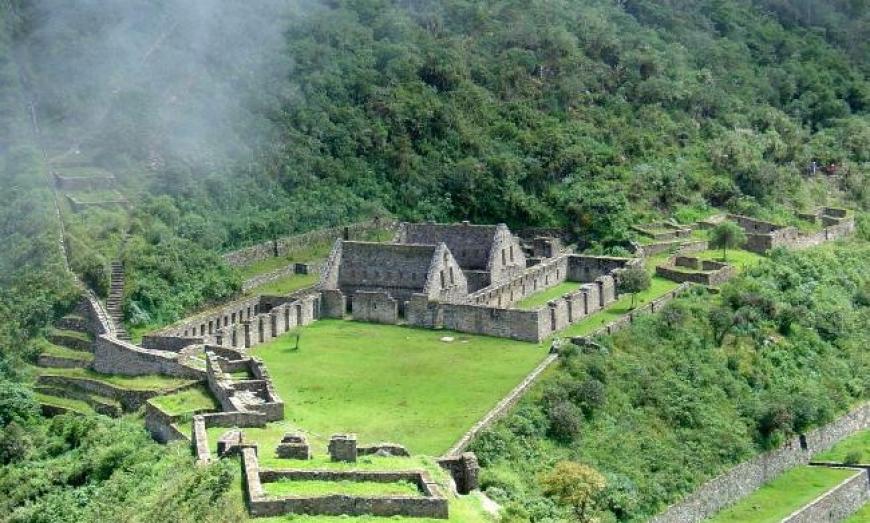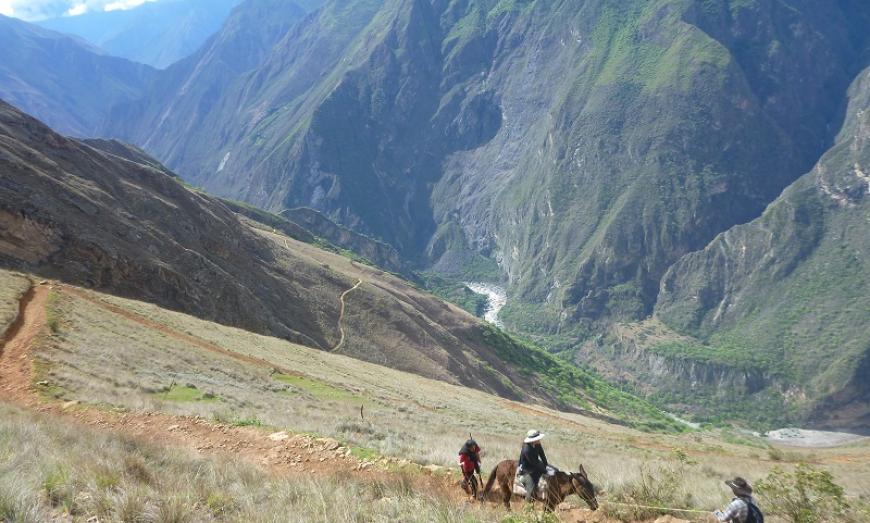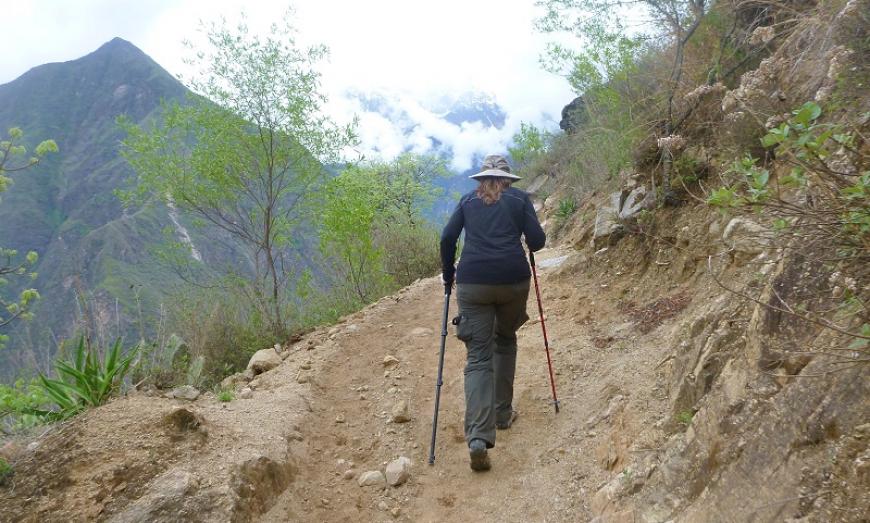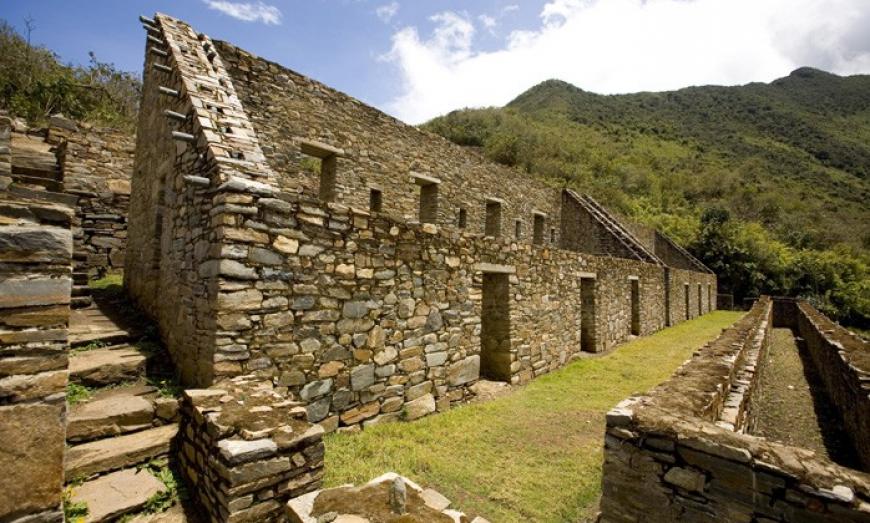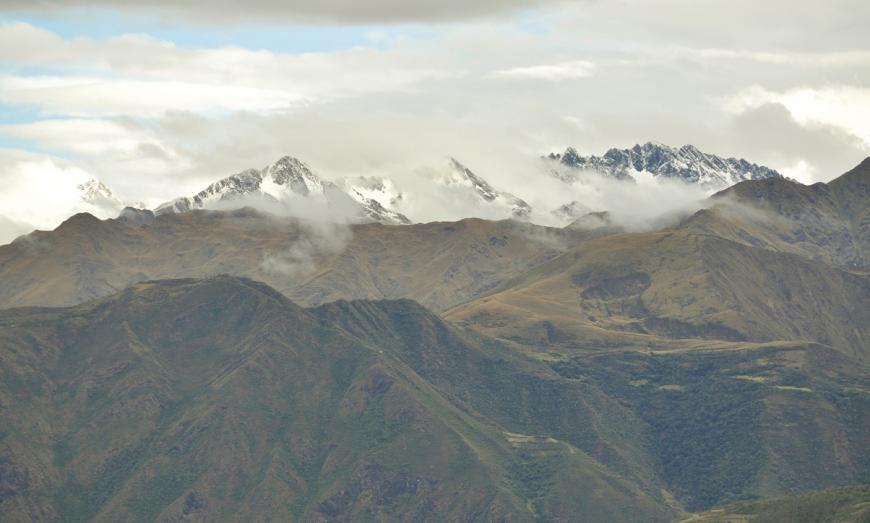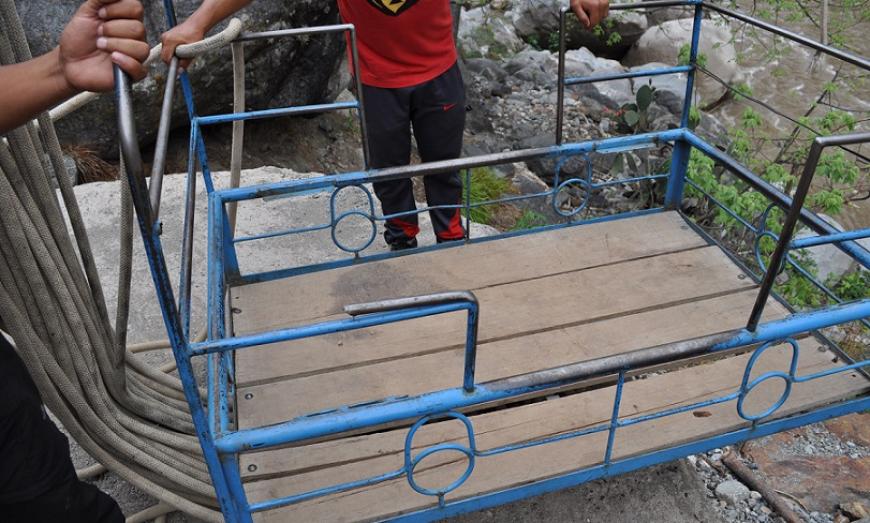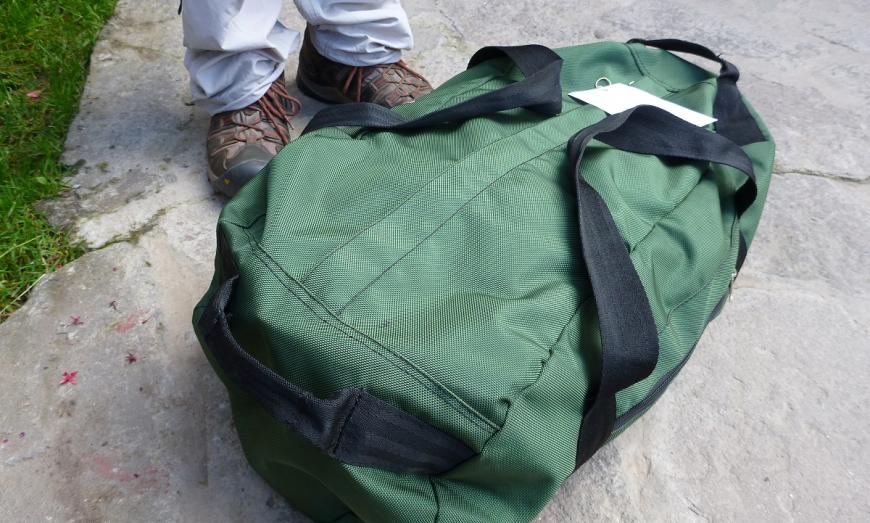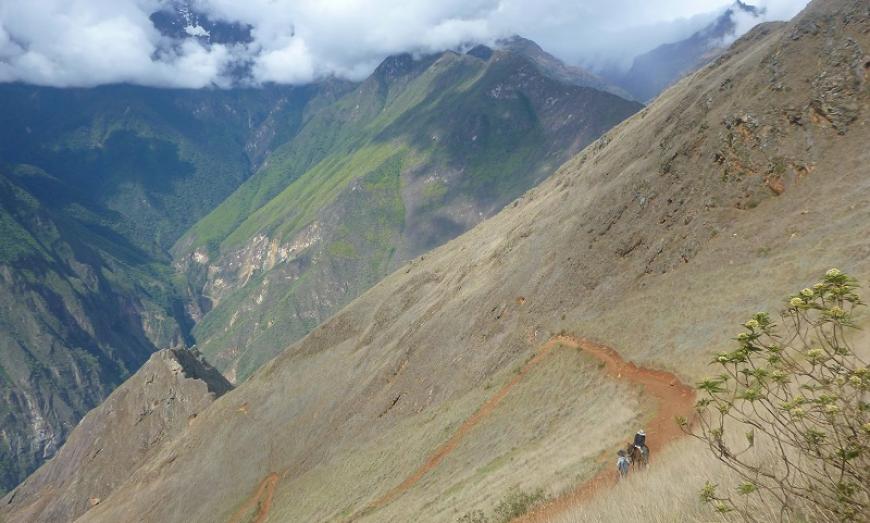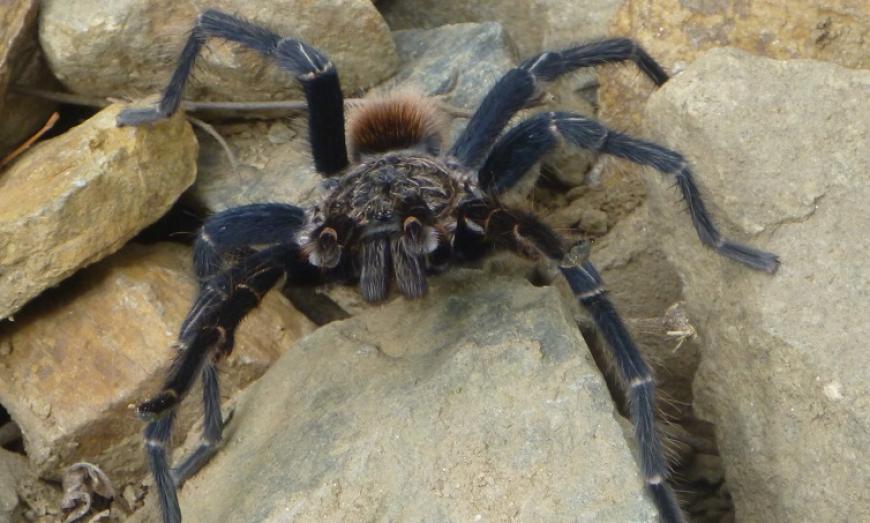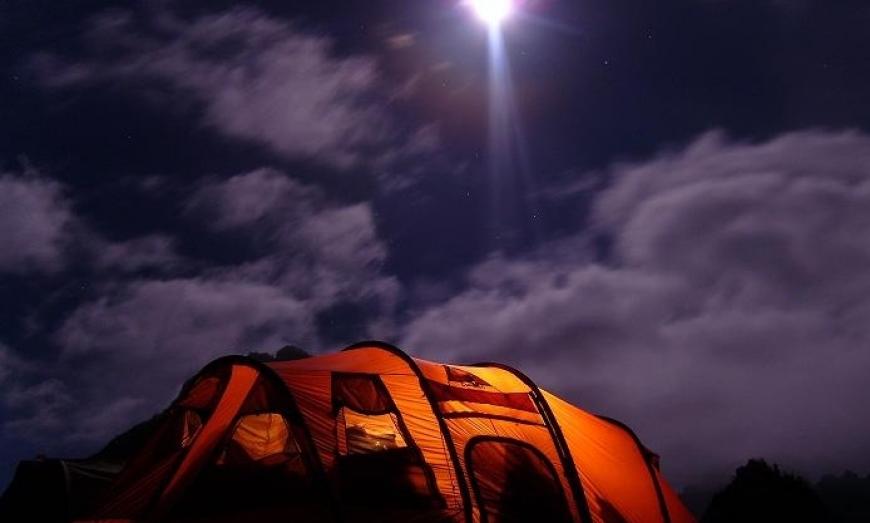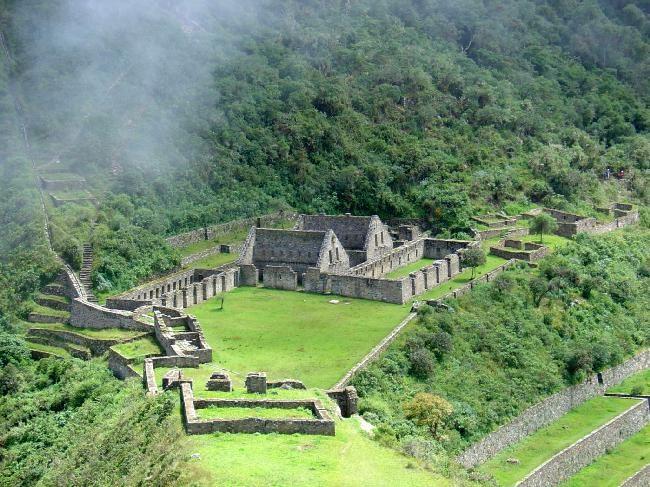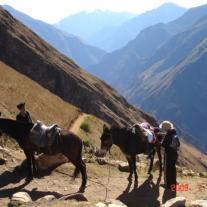
Please send me information about this trip
Private hikes available during the dry season from April to November.
Best time to hike Choquequirao is May to October. Choose your dates, then send us an email.
Day 1: Cusco – Cachora – Chiquisqa
After breakfast in your hotel around 5:30 am, our private vehicle arrives at 6:00 am to start our 5 hour journey to the village of Cachora and on to the trailhead at Capuliyoc. During our journey we stop a moment to observe the archaeological remains of Tarawasi from the vehicle then continue to the Cunyac Bridge between the departments of Cusco and Apurimac. Next we travel through the district of Curahuasi and Saywite Andean Community, and if on a Sunday, we stop at the market to sample the fruits and foods of the Andes. We continue to Cachora 2800 masl. at approximately 11 a.m., where we enter the final dirt road which will lead us to Capuyiloc Pass where the arrieros will be waiting with the mules and horses. Wranglers will load our equipment and gear while we will have lunch and enjoy the first views of the beautiful Apurimac valley stretching below surrounded by the snow-capped peaks of Padrayoc and Wayna Cachora. From Capuliyoc, if the sky is clear, we may see the tiny specks of Choquequirao on the horizon across the distant valley. We descend on wide dirt paths to Coca Masana 2330m where the climate becomes noticeably warmer and the flora and fauna begin to change. Many switchbacks over rocky paths bring us to the shady oasis at Chiquiskä at 1900m where we set up camp and spend the night in tents. In the camping area we’ll find people from Cachora living in simple huts where they offer bottled drinks for sale to the trekkers. Distance 13 KM
Day 2: Chiquisqa – Playa Rosalina – Santa Rosa – Maranpata
After breakfast around 6:00 am, we will continue our trek down, for about 1 hour to cross the Apurimac River over the hanging bridge. We start a 3 hour climb up the steepest and most difficult hill towards Santa Rosa (2115 m.a.s.l), where we stop for lunch. We continue with slightly easier climb up to the Maranpata Camp (2850 m.a.s.l) beside the Chunchumayo River where we will have a short rest. Along the way we will observe orchids and wild flowers as well as many birds, including the Andean Condor. We pitch our tents near the simple huts and make our camp for the night. Distance 11 KM.
Day 3: Day: Maranpata – Choquequirao – Maranpata
Our cook prepares a hearty Andean breakfast around 7:00 am before our 2 hour day hike from Maranpata to Choquequirao (3035m). We arrive at the archaeological site in time to enjoy the impressive views of the deep canyons and maybe the opportunity to see a Condor flying nearby. We continue our 1 hour walk to the Choquequirao archaeological complex, where our guide will conduct a three hour tour with all the details about this important Inca ruins. You’ll have time to wander alone and by 3 pm we make way back to camp at Maranpata for dinner and a beautiful sunset in an amazing setting. 4 KM / 8 KM roundtrip
Day 4: Maranpata – Santa Rosa – Playa Rosalina – Chiquisqa
Breakfast will be around 7 am, before we start descending to Santa Rosa 2115 masl., where we stop for lunch. Then continue descending to Playa Rosalina 1550 masl where we cross the Apurimac River and start our upward journey to camp at Chiquiskä 1950 masl., two hours away. We will find soda, beers from a boy named Uriel. And dinner. 11 KM
Day 5: Chiquisqa – Capuliyoc – Cachora – Cusco
After our last Andean breakfast in Chiquisqa around 06:00 am, we will return along the same route, stopping at Samana Wasi to meet Jesusa to enjoy her thick, rich coffee or homemade chicha beer. The slope we descended on the first day is a soft climb of two hours until the pass of Capuliyoc 2915 masl where we enjoy our last lunch with amazing mountain vistas. From here, our vehicle awaits to take us to the village of Cachora 2800 masl. During our journey we will observe the exotic flora and fauna as well as sights of majestic snow-capped peaks and the impressive canyon of the Apurimac. In the afternoon we travel to the medicinal thermal baths of Qonoq to relax (optional) before our drive to Cusco, arriving around 8 p.m. Hikers will be transferred to the hotel. End of the services. 13 KM
5-Day Choquequirao Trek with 3 nights hotel in Cusco:
8 Days/ $1308 USD pp / includes 3 nights 3* hotel in Cusco before & after the trek / based on double occupancy
(minimum 2 ppl)
Machu Picchu extension:
2 Days/ $637 pp / group departures based on double occupancy (includes 1 night hotel in Aguas Calientes)
2 Day / $703 pp / private - min 2 / based on double or triple occupancy (includes 1 night hotel in Aguas Calientes)
5-Day Choquequirao Trek + Hotels + 2-Day Machu Picchu Package:
10 Days/ $1888 USD pp /Min 4 ppl based on double occupancy (contact us regarding rates for groups of 2)
Tour Options
Frequently Asked Questions
Will I get altitude sickness?
It's common for most people coming from sea level to experience at least mild symptoms of altitude sickness when they arrive in Cusco, which is 11,000 ft/3430 m above sea level. Age is not a factor for the severity of symptoms one can experience. But fitness can be. We recommend that everyone arrive in Cusco at least 2 days prior to beginning your hike. Symptoms of altitude sickness vary from person to person, but can include:
-headache
-nausea
-insomnia
-fatigue
-loss of appetite
Treatments may include:
- -OTC pain reliever - bring your own favorite remedy for pain relief
- -Oxygen. Most hotels have oxygen tanks in their lobbies and guides will carry small tanks of oxygen on hikes. Some local pharmacies sell an individual size O2 tank for personal use.
- -Coca Leaf. Locals believe that drinking coca leaf tea will help and you will find the tea leaves readily available in hotel tea bars as well as restaurants.
- -Water. Drink extra to keep your blood flowing freely. Dehydration leads to sludgy blood and may contribute to your discomfort.
- -Diamox. (AKA "Acetazolamide" is a diuretic or "water pill") can be purchased by prescription in some western countries or over the counter in Peruvian pharmacies.
- -Treatments may alleviate the symptoms as you adjust in the first 24-48 hours. But it's not likely that breathlessness when climbing steps or stairs will completely disappear, no matter how you treat it. If other symtoms do not show signs of improvement within 24 hours of your arrival, please notify your travel companions or guide so s/he can monitor your progress. In rare occasions, individuals may need to seek medical attention.
Is it safe to drink the water?
Tap water in Lima, Cusco and other larger cities is consumed by local people every day. But is it safe for you? There's only one way to find out and we suggest that you not drink the tap water or use it to brush your teeth. Bottled water is cheap and available everywhere including small towns and villages. We support voluntary limits on the use of disposable water bottles and encourage you to bring a purification device to make your own safe drinking water. The device should be rated to purify water from microbes and viruses, not just for taste. Purified drinking water is provided on all the multi-day hikes and during your stay in the Amazon jungle lodges. Please bring your own water to begin the activity. Here's a link to view our favorite water filter for travelers. And we scored a discount for our followers!
What equipment do you provide for hikes?
Porters will carry tents for sleeping, cooking, dining & urinating (we provide a special tent for "pee pee" which has biodegradable toilet for #1. We could call it the "girls'" tent, but we won't). And we provide all kitchen and cooking supplies including the food that is served. We do not provide sleeping bags, trekking poles or big, fluffy pillows. With advance notice, sleeping bags can be rented for $20 pp. Trekking poles are available to rent for $20 pp for multi-day hikes and $8 pp for 1 day hikes. Our sleeping bags are Sierra Designs/North Face/Mountain Hardwear brand mummy bags rated to 20 degrees or 30 degrees F. If you choose to rent a sleeping bag, we ask you to provide your own bag liner. We also provide Therma-rest Basecamp regular-size mattresses. If you are over 6' 4/190 cm, please bring your own mattress or let us know & we'll tape 2 mattresses end to end (just kidding - like the big, fluffy pillows). We provide duffle bags for multi-day hikes.
How do I know if I'll need an extra porter for my hike?
All multi-day hikes with Adios Adventure Travel include 2 porters per hiker. This is our standard. We do this as much for the porters as for the hikers. One way to protect porters from abuse is to ensure that there are enough porters to distribute the load. And another way to show appreciation for porters is to pay them living wages. Which we do. It's at your discretion to tip porters. Customary amount is $25-$35 each after the hike. You are free to tip any amount you can afford.
What is the best way to travel between Lima and Cusco?
We recommmend flying between the cities because other means requires more time or is not practical for short vacations. There is no train service between Lima and Cusco. And while there is bus service, the drive is almost 24 hours long over paved, but winding mountain roads. There is no speedy highway. The cost of round-trip air tickets varies from around $250 pp on the domestic carriers, including SKY AIRLINES and u[ to $450 pp on LATAM AIRLINES. The majority of the flights between the cities occurs in the morning to mid-day hours. Afternoon flights taper off by 5 pm and there are no evening flights in either direction due to mountain weather conditions.
Where should I stay if my international flight arrives in Lima in the evening?
There is only one hotel at the Lima airport. The Wyndham Hotel is connected to the arrivals terminal by a skybridge on the 2nd floor. It takes literally 2 minutes to walk from the terminal to the lobby of the hotel. The hotel is expensive by Peruvian standards (in excess of $200 USD per double room per night). We've seen good rates on booking.com and hotels.com The hotel will accommodate as many as 3 to a room, but not 4.
This hotel is best for groups who arrive in Lima late evening and plan to depart again by air the next day. For groups planning to stay in Lima, it's best to pre-arrange a transfer to a hotel in the Lima city center. There are no shuttle buses except for the Sheraton Hotel across the street from the airport. Ask your hotel to arrange a driver to meet your flight. The travel time is about 45 minutes each way when the traffic is moderate. And the cost ranges from $35 each way and up. If your group is larger than 3 persons, you may need a transfer in a mini-van or two taxis.
Do I need vaccinations to visit Machu Picchu?
The altitude of Machu Picchu is 8000 ft/2440 m and higher. Disease-carrying vectors do not thrive at higher elevations. US passport holders are not required to get Yellow Fever vaccinations or prophylactic Malaria treatments. Although there have been no recent cases of Yellow Fever in Peru, some countries, including the US, recommend that visitors get Yellow Fever vaccinations prior to visiting the Amazon Rainforest including Tambopata Reserve or Manu National Reserve. We recommend that travelers check the regulations for re-entry for any countries they will pass through after leaving Peru, Bolivia or Ecuador. Bolivia requires all foreigners to have proof of yellow fever vaccination upon entry if you plan to travel to the Bolivian Amazon jungle. (Some countries including Australia, require their citizens to get yellow fever vaccination if they enter Peru, even if they are only visiting the higher elevations) As these regulations may change from time to time, it is the responsibility of travelers to consult their own government health departments for up to date and relevant information.
This Adventure Includes
- Transportation (round trip starts & ends in Cusco)
- Complete camping equipment (except sleeping bags/trekking poles - bring your own or rent ours for $20/$20 pp)
- Full meals (B-L-D-S) s=snack
- Use of our trekking poles
- Professional, English-speaking guide
- Mules to carry the equipment
- Porters & wranglers
- Entry fee
Not Included
- Flights
- Trip to Machu Picchu (is ideal to go to MP before the trek to allow time to acclimatize.
- Sleeping bags - bring your own or rent ours for $20 pp (bring sleeping bag liner if you are renting our bags)
- Tips at your discretion
- Hike 2 day Inca Trail to Machu Picchu (can be added with 2 days/1night extra)
- Travel Insurance
- Airport transfers (available on request)
- Accommodations in Cusco (available on request)
Notes
- No experience necessary, but good fitness is key to success
- Mules carry the equipment
- Choose private or open departures on any date
- We loan duffle bags for up to 5.5 kg/11 lbs your personal gear. This includes the weight of the sleeping bag and therma-rest mattress even if we provide it.
- Your luggage will remain at your hotel in Cusco until you return
- We bring an extra horse in case of injured or sick hiker, not for recreational riding
- Private hikes can be organized from April through November, during the dry season
- All our hikes include superior comfort upgrades - therma-rest mattresses, 2 porters/wranglers per hiker, well-trained trail chef, high-quality meals, English-speaking guides

